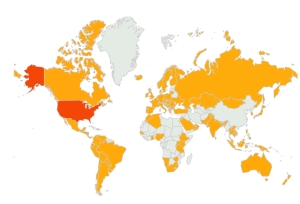As we near the end of this project, it’s time to look at the stats and see which social media platforms were most effective.
The four most effective sources of hits to the site were:
Facebook: 37%
LinkedIn: 23%
Search engines: 15%
Twitter: 9%
The rest of the referrals included virtually every social media platform that exists, including; Reddit, StumbleUpon, Hootsuite, Pinterest, Instagram, Google+, YouTube, and WordPress Reader. Also there were about 100 re-blogs and ping backs. Google generated nearly 98% of the search engine traffic. Bing, Yahoo, AOL, Ask.com, WordPress Search only generated a handful combined. While Facebook posts and shares resulted in the highest number of visitors, LinkedIn generated the most audience engagement, i.e., comments, blog followers, and discussions. E.mail shares generated about 4% of total hits.
There was a very successful building of community around this project, both geographically and professionally. There were regular comments and shares from consistent followers on Facebook, Twitter, and LinkedIn forums. Repeat visits from a Central American audience generated much local conversation about OYE, and there was a global following from the NGO and academic community. Social media experts, interested in the process, followed consistently as well.
The Twitter numbers reaffirm my earlier conclusion; it is the online equivalent to direct mail. Although there were well over 3/4 of a million total impressions on Twitter (with about 250 re-tweets), there was a relatively small percentage of traffic as a result.
About 50% of LinkedIn hits came from my own profile. The rest came from forum postings that generated considerable international discussion. Two forums in particular generated a lot of traffic: “Global Issues,” and “The Cherie Blair Foundation for Women.” The latter facilitating much discussion in The U.K. and Continental Europe. Many thanks to the forums and their members for spreading the word about OYE’s tireless work for the children of Honduras.
There was a great deal of global exposure to the blog. The United States (the main source of OYE’s funding) generated about 55% of total visits, with the other top ten visitor countries being: Honduras (local exposure), The U.K., Guatemala, Canada, Germany, India, Australia, Spain, and Pakistan, in that order. There were also large numbers of visitors from The Netherlands, Ireland, Mexico, Italy, and Switzerland. There were no hits from China. Total countries with visitors included about 97% of the Western Hemisphere, all of Western Europe, all of Scandinavia (including Iceland), most of Eastern Europe, and big chunks of Asia/Pacific, the Middle East, & Africa.
Some conclusions: Facebook was the best venue for distribution that resulted in hits. LinkedIn provided the best audience engagement. The WordPress format is very effective for search engine visibility, and it provides meaningful stats. Plus, the WordPress share buttons were extremely effective, especially for Facebook sharing. Twitter can generate a lot of hits but requires a great deal of effort in contacting relevant Twitter sites. Although there was no specific effort to generate traffic from YouTube on this particular project (the videos were uploaded directly to the WordPress blog, but to YouTube as well), there were over 400 hits to the YouTube versions as a result of tags (Honduras, OYE, NGO, etc.).
Thanks again to everyone who shared, followed the blog, and participated in discussions about this worthy project to empower youth in the difficult circumstances of Honduran society. Special thanks to Laureate International Universities who sponsored the travel portions of this project, TACA airlines that discounted my flights (and gave me free upgrades), and The International Youth Foundation that posted links to this blog on their social media outlets.
-Richard Lakin




The NGO World: A journey from an e.group to an NGO
http://tnwpk.wordpress.com/